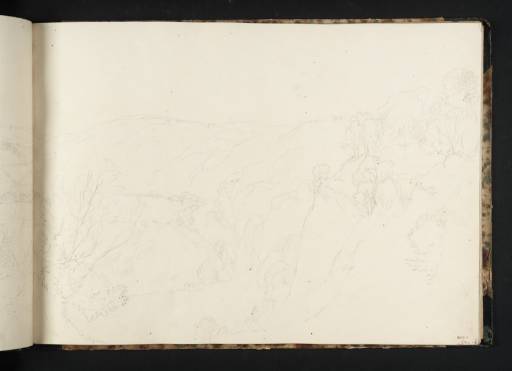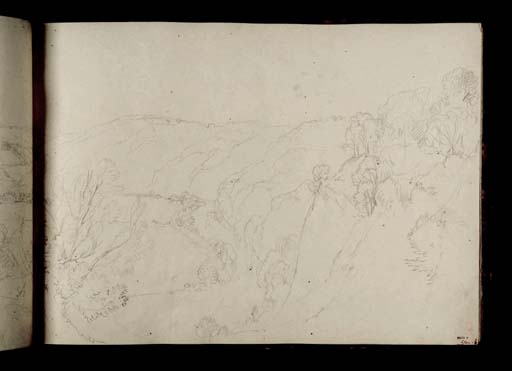Joseph Mallord William Turner Gibside and the Derwent Valley from Winlaton Scar 1817
Image 1 of 2
Joseph Mallord William Turner,
Gibside and the Derwent Valley from Winlaton Scar
1817
Joseph Mallord William Turner 1775–1851
Folio 10 Recto:
Gibside and the Derwent Valley from Winlaton Scar 1817
D12268
Turner Bequest CLVI 6
Turner Bequest CLVI 6
Pencil on white wove paper, 232 x 328 mm
Watermark ‘J Whatman | 1816’
Inscribed by John Ruskin in red ink ‘Glen.’ bottom right
Inscribed in pencil ‘6’ bottom right
Stamped in black ‘CLVI 6’ bottom right
Watermark ‘J Whatman | 1816’
Inscribed by John Ruskin in red ink ‘Glen.’ bottom right
Inscribed in pencil ‘6’ bottom right
Stamped in black ‘CLVI 6’ bottom right
Accepted by the nation as part of the Turner Bequest 1856
References
1909
A.J. Finberg, A Complete Inventory of the Drawings of the Turner Bequest, London 1909, vol.I, p.447, CLVI 6, as ‘Another view of Gibside, near Swalwell, on River Derwent’.
1994
[Evelyn Joll], Watercolours by J.M.W. Turner R.A. (1775 – 1851), exhibition catalogue, Thos Agnew & Sons, London 1994, p.[10] under no.3.
2006
Michael Rudd, ‘Retracing Turner’s Sketching Tours: A Topographical Journey’ in Emma House, Michael Rudd and Paul Clark, Joseph Mallord William Turner: Tours of Durham and Richmondshire, exhibition catalogue, Bowes Museum, Barnard Castle 2006, p.46, as sketch of ‘Gibside from the north’ pl.34 (right-hand side, as ‘Gibside from the South’).
2006
Michael Rudd, ‘Gibside – from Sketch to Engraving’, Turner Society News, no.102, March 2006, p.6.
This panoramic view south-west over the Derwent Valley towards Gibside continues to the left across folio 9 verso opposite (D12267; Turner Bequest CLVI 5a). The main focuses of interest, the house and Column of British Liberty, appear towards the right of the opposite page; on the present page the River Derwent is shown flowing from the south-west towards Turner’s viewpoint on Winlaton Scar1 before turning to the south-east immediately below, towards High Dam (again shown on the opposite page). The wooded slopes of Scar Bank to the right, and Paddock Hill in the distance towards the left, flank the west bank of the river. The woods in the right-hand third or so of the drawing were omitted from the composition of the subsequent watercolour (Bowes Museum, Barnard Castle)2. Most of the double-page view is repeated from a slightly different position on the verso of the present leaf (D12269).
Evelyn Joll has dated the drawing as ‘probably’ from the week of 23–29 October 1817,3 although this is perhaps too literal an interpretation of Turner’s November 1817 letter recounting his recent movements (see the introduction to this tour).
Further studies of Gibside and the surrounding landscape are on folios 6 verso to 9 recto, 11 recto and 11 verso (D40723, D12265, D40724, D12270, D12271, D12266, D12272, D12273; CLVI 3 verso–4, [4 verso]–7, 7a, 5, 8, 8a). See the introduction to the tour and the entry for folio 6 verso (D40723) for more on the history of the house and estate.
Technical notes:
The pencil number ‘6’ may obscure or reinforce John Ruskin’s customary red ink foliation, which is evident only faintly and intermittently in this much-rearranged book (see the introduction to the sketchbook).
Matthew Imms
February 2010
How to cite
Matthew Imms, ‘Gibside and the Derwent Valley from Winlaton Scar 1817 by Joseph Mallord William Turner’, catalogue entry, February 2010, in David Blayney Brown (ed.), J.M.W. Turner: Sketchbooks, Drawings and Watercolours, Tate Research Publication, December 2012, https://www


